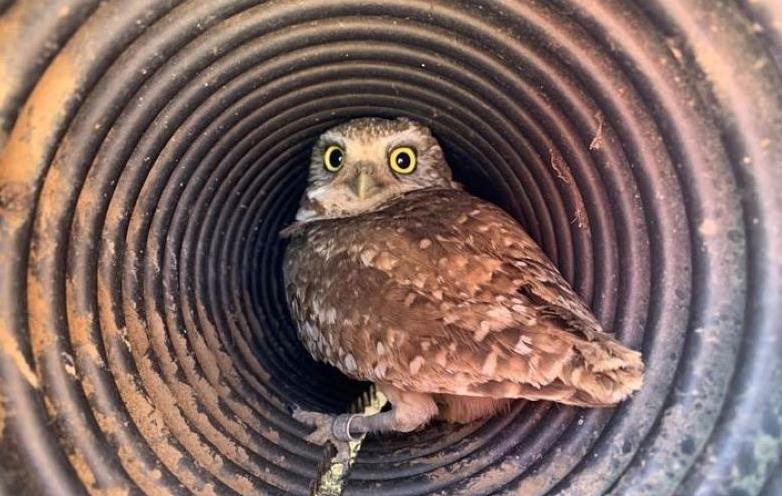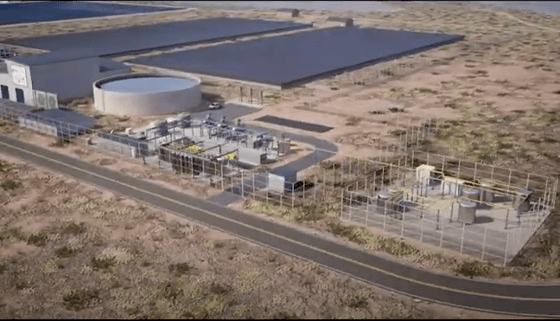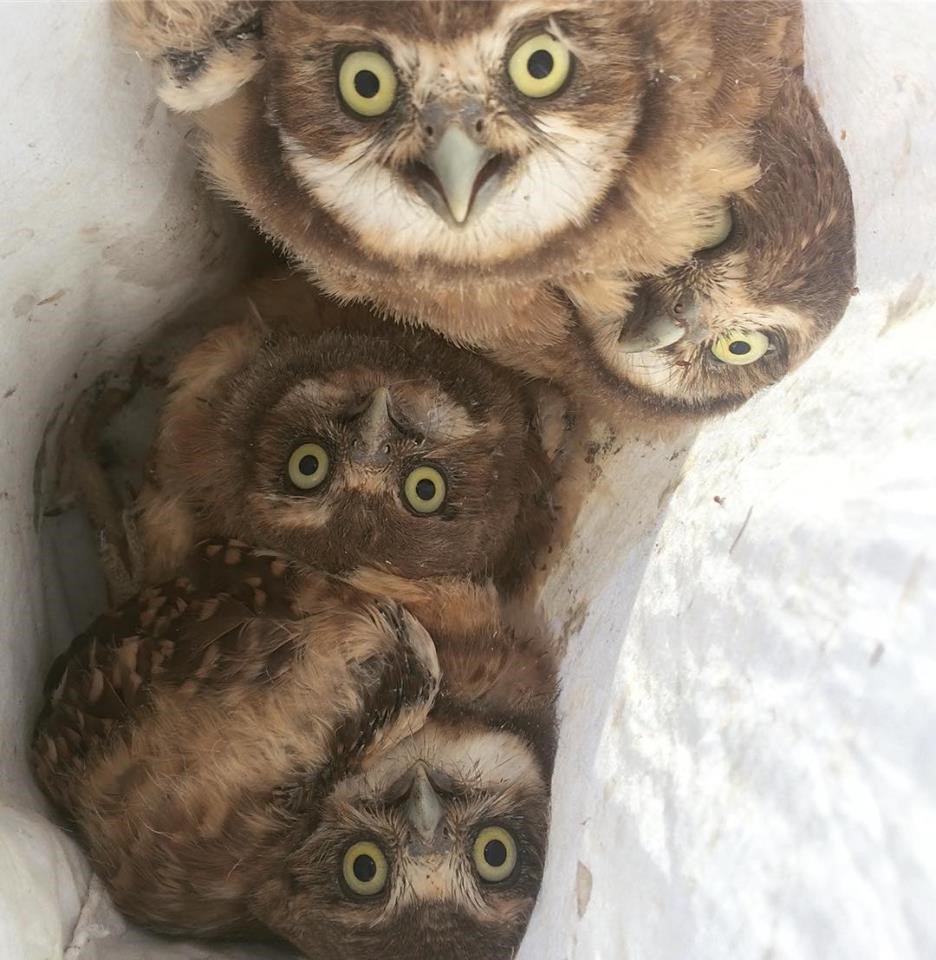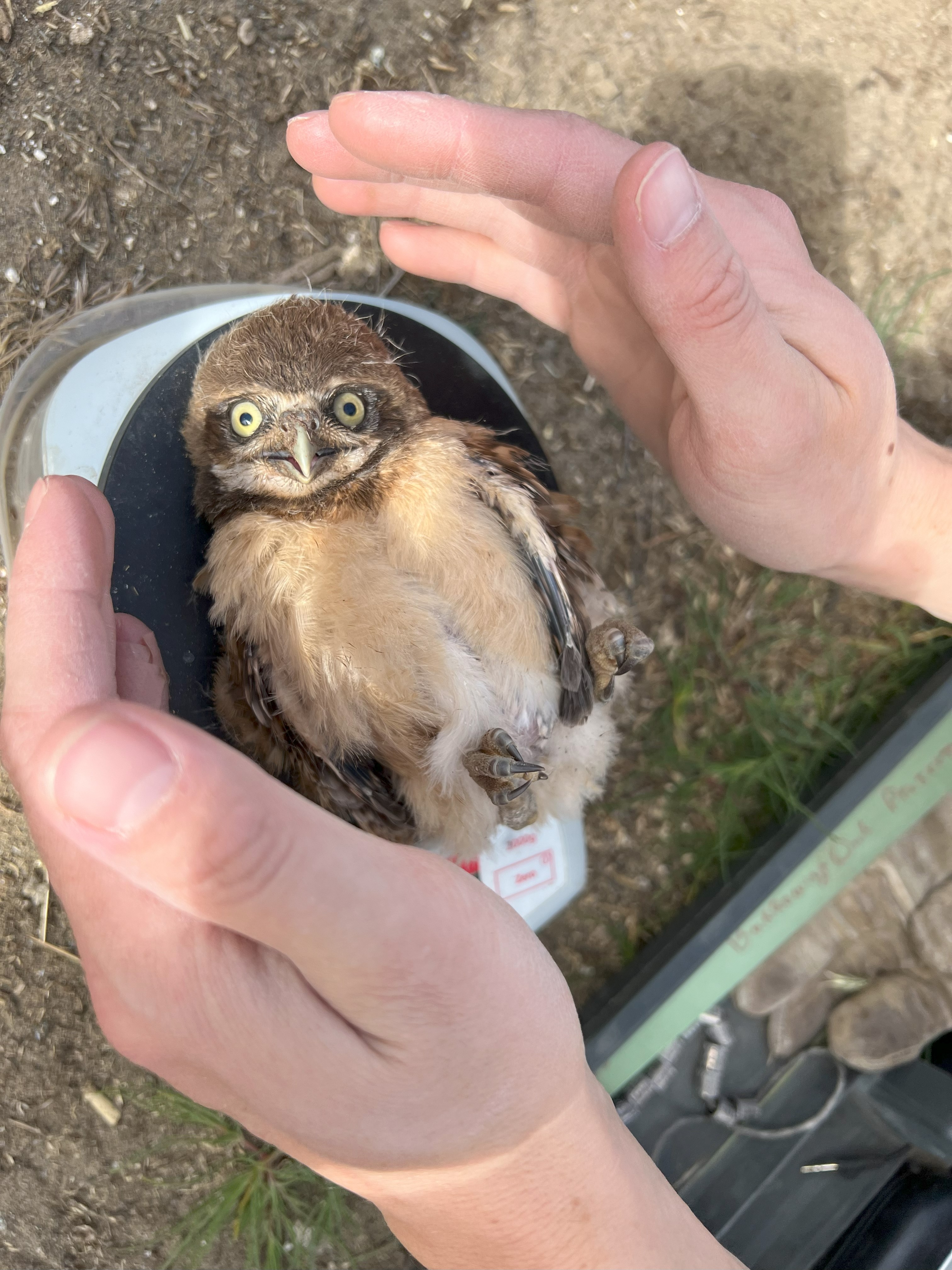
Banded owl in entrance of artificial burrow.
The City of Pasco’s Process Water Reuse Facility expansion is essential for meeting the growing wastewater treatment needs of local industries. This facility takes wastewater from food processing companies and treats the water (using algae) so it can be used in other ways. Recycling water reduces the burden on the city's public wastewater treatment plant and helps protect water quality in the Columbia River. The expansion began in 2023 and is still in progress.
Aerial view of the Pasco Water Reuse Facility. Courtesy of City of Pasco. 
The City of Pasco was awarded funding from Ecology’s competitive clean water funding process. They received loan money from the Clean Water State Revolving Fund; one of six funding sources in the Water Quality Combined Fund. The estimated total project cost is $180 million.
When a recipient receives a loan from the Clean Water State Revolving Fund, the project must undergo a State Environmental Review Process to make sure it follows all relevant regulations. During the environmental review, it was determined that the project area contained approximately 440 acres of shrubsteppe and grassland habitat; prime land for the burrowing owl, a species protected under the Migratory Bird Treaty Act.
Recognizing the potential impacts to the owl population, we worked closely with wildlife experts from the Washington Department of Fish and Wildlife (WDFW) and the U.S. Fish and Wildlife Service (USFWS) to ensure that a mitigation plan was in place to protect this vulnerable species. The expansion of the Pasco Process Water Reuse Facility has been an example of how working together can lead to successful wildlife conservation and clean water infrastructure projects.
Young owls ready for banding and release. Courtesy of Jason Fidorra, WDFW. 
About the burrowing owl
The burrowing owl nests in underground burrows created by other animals, such as ground squirrels and American badgers. These owls are found in open, sparsely vegetated areas, including grasslands, prairies, and agricultural fields. In Washington, burrowing owls are rare, and their population has sharply declined due to habitat loss and disruption caused from development projects. In the Columbia Basin region, which includes Pasco, the owl's range has been shrinking in recent decades. A critical threat to their survival is the destruction of the burrows they rely on for nesting and shelter. If you want to learn more about the burrowing owl and their biology, check out the WDFW website.
A young owl on a scale to record weight during banding. Courtesy of Jason Fidorra, WDFW. 
Protecting the burrowing owl
To avoid any harm to the burrowing owl population, we worked with WDFW and Rh2 Engineering (the consultants hired by Pasco to handle environmental impacts) to develop a mitigation strategy. The approach focused on minimizing impacts through pre-construction surveys, habitat protection, and the creation of artificial burrows for displaced owls.
Detailed biological surveys assessed the presence of active owl burrows and breeding sites. These surveys were carried out in both the breeding and non-breeding seasons to ensure that all owl activity was monitored, including the presence of overwintering owls. The surveys confirmed the existence of several active burrows within the project footprint, including two occupied burrows discovered outside the breeding season.
The mitigation plan included a "displacement" strategy to safely evict owls from their natural burrows. This process was carefully timed to occur outside of the breeding season, with artificial burrows installed prior to eviction. The displacement strategy also ensured that no other wildlife was trapped during the burrow destruction.
To offset the loss of natural burrows, seven clusters of artificial burrows were installed on the site. These burrows were arranged in clusters to create suitable breeding sites for displaced pairs of owls. The results of ongoing data monitoring showed that three pairs of owls successfully raised young in 2024, illustrating that the mitigation efforts were effective in maintaining the local population. This project navigated the challenging situation of displacing owls from their natural burrows during the non-breeding season, without a noticeable loss of their productivity during the breeding season.
Artificial burrows can help the owl population survive and even grow, as long as there are still good areas for them to hunt and find food. They often rely on neighboring agricultural fields to hunt, which benefits local landowners by removing excess rodent populations.
“With up to 13 hungry chicks to feed during the breeding season, an owl pair removes a lot of rodents from adjacent agricultural fields, benefiting both local landowners and the owls,” said biologist Jason Fidorra from WDFW.
Navigating construction windows
An essential part of construction projects with protected species is getting the timing of the work right. Construction windows ensure that the work does not overlap with critical periods for wildlife behavior, such as nesting or breeding seasons.
Another important element during construction is the placement of disturbance buffers around the occupied burrows (at least 500 feet or more). This helps prevent construction equipment from disturbing the owls or causing burrows to collapse.
Takeaways
The Pasco Process Water Reuse Facility expansion serves as a valuable case study in how development projects can coexist with wildlife conservation efforts. We had several key takeaways that emerged from the project that can help inform other communities for future infrastructure projects involving sensitive species:
-
Pre-construction surveys: The presence of two occupied burrows outside of the breeding season highlighted the importance of conducting pre-construction surveys. Burrows that are occupied during the winter months may be used again for nesting in the spring, making it crucial to protect these sites year-round. Burrows provide important protection from predators and weather during the off-season, and occupied non-breeding season burrows are often nest sites used in the breeding season. These sites are essential to burrowing owls and should be provided protection year-round like active nesting sites.
-
Pre-construction mitigation: The success of the displacement and mitigation efforts demonstrated the importance of taking proactive measures before construction begins. Installing artificial burrows and implementing disturbance buffer zones ahead of time can significantly reduce the impact on wildlife.
-
Owls need access to prey: Burrowing owls require more than just burrows to survive. The surrounding landscape must also provide adequate prey. The area where the artificial burrows were placed had a reduced availability of grassland and shrubsteppe habitat, which may change prey availability.
-
Assess wildlife impacts: While we were able to collaborate to minimize the impacts to the burrowing owl, if possible, it’s best avoid impacts to wildlife first, minimize impacts second, and intervene only if necessary.
-
Artificial burrows require maintenance: After artificial burrows are set up, they can get blocked or damaged by animals like coyotes and rodents, making them useless. To keep them available for burrowing owls each spring, the burrows need regular maintenance every year. This easy and inexpensive upkeep helps ensure that the owls can use the burrows for a long time.
A collaborative success
This project serves as an important example of how careful planning and mitigation strategies can support infrastructure investments without negatively impacting our ecosystems. With Washington Department of Fish and Wildlife, U.S. Fish and Wildlife Service, and the city working together with us, we were able to address the impacts of the project to the burrowing owl and navigate the challenging situation of displacing owls from their natural burrows during the non-breeding season without an obvious loss in productivity.
By making sure construction activities are compatible with wildlife protection laws such as the Migratory Bird Treaty Act, we can continue to build infrastructure while working to minimize our impacts to the natural world.

